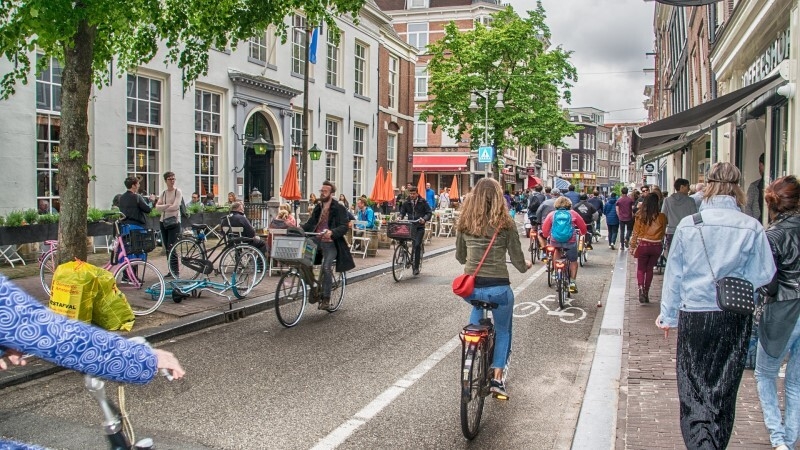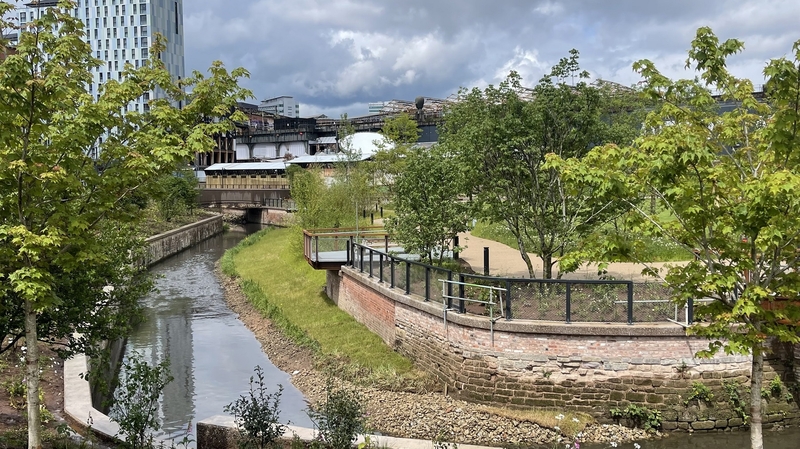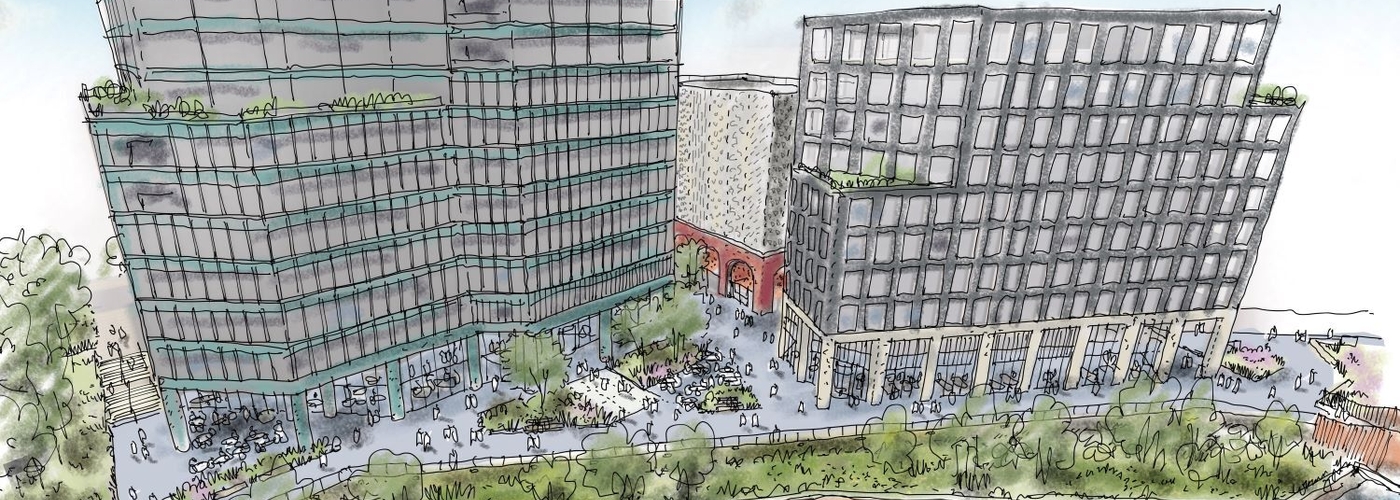Jonathan Schofield muses on Mayfield about bikes and smoking a pipe underwater
Planning has been submitted at Mayfield for a pair of buildings and a transport hub. The plans have been brought forward by the 'Mayfield Partnership, a public-private venture made up of LandsecU+I (the regeneration arm of Landsec), Manchester City Council, Transport for Greater Manchester and placemaking and regeneration specialist LCR. Subject to planning consent, work will begin on Mayfield Phase One later this year.'
This phase is a £400m Landsec development. The overall Mayfield scheme will come in at an expected £1.5bn.
Both buildings look sensible rather than eye-catching
The new building are in many ways a continuation of permission sought in 2020. The only significant difference to the proposals is an upgrade for two-wheels at the expense of four in the proposed multi-storey car park.
Thus: ‘The multi-storey car park, designed by Studio Egret West,(will) be remodelled as a multi-use building, featuring one of the city’s biggest, single-site cycle parking for over 400 bicycles. It will feature a series of brick arches, which mirror the historic railway arches at Mayfield Depot, with ground floor cafés, bars, restaurants and event spaces’.
There would also be room for 450 cars, so four wheels still marginally tip the balance, although the car provision is ‘designed to be able to be repurposed with another use as demand for car parking spaces reduces over time’. The boost to bike provision is in line with current architectural trends.

All we need now is to convince sufficient numbers of the population to opt for bikes as a method of getting around.
I am an avid cyclist but a quick straw poll of nine people in the Confidentials' office wasn't encouraging. Staff varied in ages from the early twenties to late sixties and only two are prepared to regularly cycle in the city and one of them is me.
It’ll be interesting to see where we are in the UK in five years and whether more of the general population have adopted cycling. It gets tedious when lycra-clad bike prophets quote Amsterdam and Copenhagen because the context and make-up of those cities is very different from big British cities. Perhaps the apparently arbitrary and unmodelled closing of city centre roads and squares to cars will force more people to learn the love of the pedal as it gets more difficult to traverse the city by vehicle.

Back to Mayfield.
The other two buildings are substantial but not tall by recent Manchester standards. They are both commercial buildings and will on the southern bank of the River Medlock up against the Mancunian Way. The relatively low height of the buildings will ensure more light for the splendid Mayfield Park. The overall amount of lettable space across the new buildings will be 320,000 sq ft of office space.
The smaller building, The Poulton, at ten storeys is designed by Bennetts Associates who recently submitted plans for a proposed tower on Piccadilly and the associated rescue of the Union Bank. The story behind the latter was a popular read on Confidentials. The name of Bennetts' Mayfield building is a nod to the former Mayfield Baths on the site and the remarkable George Poulton, there’s more about him in the feature box below.
The larger building, The Republic, at around 14 storeys comes from Morris+Company, their first Manchester building. This appears in the proposal to be largely a glass building while the Bennetts' building is chunkier, more solid. The Republic's name refers to the fact that its ground floor will be a public and cultural space. What a curious process is the naming of developments.
Both buildings look sensible rather than eye-catching. This restraint is a good idea as Mayfield Park provides all the beauty needed here as we've reported on several occasions. The park was designed by Studio Egret West who are behind the transport hub here.

The three buildings tick all the environmental boxes, 'targeting a 5.5-Star rating under the NABERS system – widely considered to be a world leading environmental performance rating tool for commercial buildings.'
That's all a bit technical. What will be more welcome for most of us amid the press release's welter of references to 'well-being' and 'sustainability' is 'an additional 3-acres of public spaces'. This 'will extend Mayfield Park to the surrounding buildings contributing new landscaped areas, additional tree-planting, ecology and rain gardens'.
That is very good news.
George 'Natationist' Poulton - 'The Dying Gladiator'
Early in its history Mayfield Baths was visited by the premier ‘natationist’ of his day. This means an advocate of swimming and the man was the remarkable Professor George Poulton. He first appears at Mayfield on 7 July 1859 when, although suffering somewhat from a cold, ‘he went through his performance with his usual skill and concluded to the seeming great delight of the numerous spectators, by eating a sponge cake, drinking a bottle of milk and smoking a pipe, whilst totally immersed in water.’ Seven ‘young gentlemen’ then competed to swim 378ft, or six lengths. A silver medal was awarded.
In subsequent visits there is more colour to the descriptions, in the reports from the Manchester Guardian. Poulton would also ‘give some fine specimens of scientific swimming and floating, illustrating a dead man, ‘The Crucifix’, ‘The Dying Gladiator’, turned eight summersaults in the water without touching the bottom. He drank a bottle of milk, which he did by holding the bottle in his mouth, and with arms extended immersed himself about six inches below the surface and rose after swallowing the contents. He then smoked a pipe while under the water, the bowl only remaining a little above. He was of such an amphibious nature that the water was as much his element as terra firma.’
Poulton subsequently ran classes at the baths and as late as 1883, ‘Poulton and some pupils, male and female, gave an exhibition in the ladies’ swimming bath, and in July he swam twenty-one yards on his back, in one stroke, starting from the shallow end’.
By this time, although still a swimming teacher, he was also running a pub on Medlock Street in Hulme called the Griffin Inn. Aside from regular duties at Mayfield Baths, where in one letter he defends the bath water from being described as ‘murky’ and the attendants from not being able to swim, he runs swimming events all over the country, both indoor and outdoor. In 1864 he was seriously injured in a train crash during a Birmingham excursion. He also ran shooting and fishing competitions. He died in 1898.
If you liked this article you will like:
Olympic gold medals forged in the baths
The Northern Quarter Park
Get the latest news to your inbox
Get the latest food & drink news and exclusive offers by email by signing up to our mailing list. This is one of the ways that Confidentials remains free to our readers and by signing up you help support our high quality, impartial and knowledgable writers. Thank you!
















